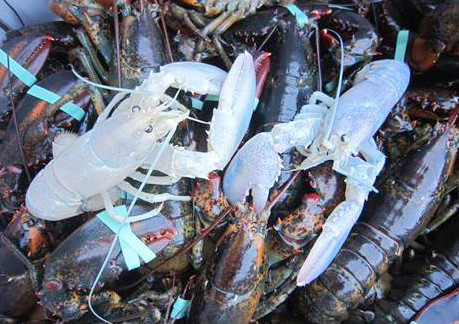Albino lobsters — the rarest of all the crustacean’s color mutations — are believed to be about one in 100 million.
So, what are the odds of two midcoast lobstermen catching two albino lobsters within a week for same lobster pound?
Maybe too unlikely to be true.
On Thursday, lobsterman Bert Philbrick caught a white lobster off Owls Head, less than a week after Joe Bates caught one about a mile off the Rockland breakwater. The pair look ghostly compared to the greenish-brown lobsters that normally come up in traps along the coast.
The white shells naturally led to the conclusion that the lobsters were ultra-rare albinos. But Bob Bayer, executive director of the University of Maine’s Lobster Institute, isn’t so sure.
Bayer said he’s only seen a couple of albino lobsters in his lifetime.
“We get blues (and) we get red ones every summer. That’s not a big deal. This is,” he said, if they’re actually albino.
Looking at a picture, however, Bayer said, it seemed at least one, if not both, have a blueish hue.
“I don’t think they’re albinos. It looks like there’s some pigmentation there,” he said.
Still, whatever they are is highly unusual, said Bayer. “It’s nothing I’ve seen before.”
Neither has Bates, who has 300 traps off Rockland and has been lobstering since 1990. He also caught a yellow lobster Monday, estimated to be one in 30 million, but that wasn’t a first.
“I was surprised. Shocked, actually,” he said about the seeing the white lobster in his trap.
Both white lobsters were under legal size — about 5 or 6 years old, estimated Terry Watkinson, owner of the Owls Head Lobster Co., where the fishermen brought their rare catches.
Normally, that would mean they’d have to be thrown back into the ocean to mature for another year or two. But the Maine Marine Patrol occasionally makes exceptions.
On Friday, they were still floating in a crate at the Owls Head lobster pound. They wouldn’t be for long.
One was claimed by Brooks Trap Mill, a Thomaston lobstering supply store with a tank full of marine life. The other is destined for the Maine State Aquarium in Boothbay Harbor, adding to the spectrum of colored lobsters already on display there.
That’s where a blue lobster caught two weeks ago off Pine Point in Scarborough was taken. Blue lobsters are estimated by the Lobster Institute to be one in 2 million.
Earlier this year, a lobsterman pulled a one-in-30 million calico lobster, sporting patches of orange and dark blue on its shell, out of a trap in New Hampshire. It was sent to a Hampton aquarium. In late July, a bright yellow lobster of unknown origin ended up in a supermarket tank in Florida, where a customer bought it and sent it to an aquarium in Rye, New Hampshire.
But all of those colorful catches would pale in comparison to coming across an elusive albino, let alone two.
That’s even considering that the estimates of how rare each color is are “an absolute guess,” Bayer admitted.
If more similar-looking lobsters are caught in the area, he said, there’s probably been “some sort of unusual breeding.”
As for the lobsters caught this week, Bayer said he would like to see them stay around for a while and get fed food high in carotenoids, like crab and periwinkles. Such food will darken the shell, if they’re not albino.
A quicker test would be to cook them. True albinos would stay white, Bayer said.
But no one’s suggesting that.
Leslie Bridgers can be contacted at 791-6364 or at:
Twitter: @lesliebridgers
Send questions/comments to the editors.




Comments are no longer available on this story